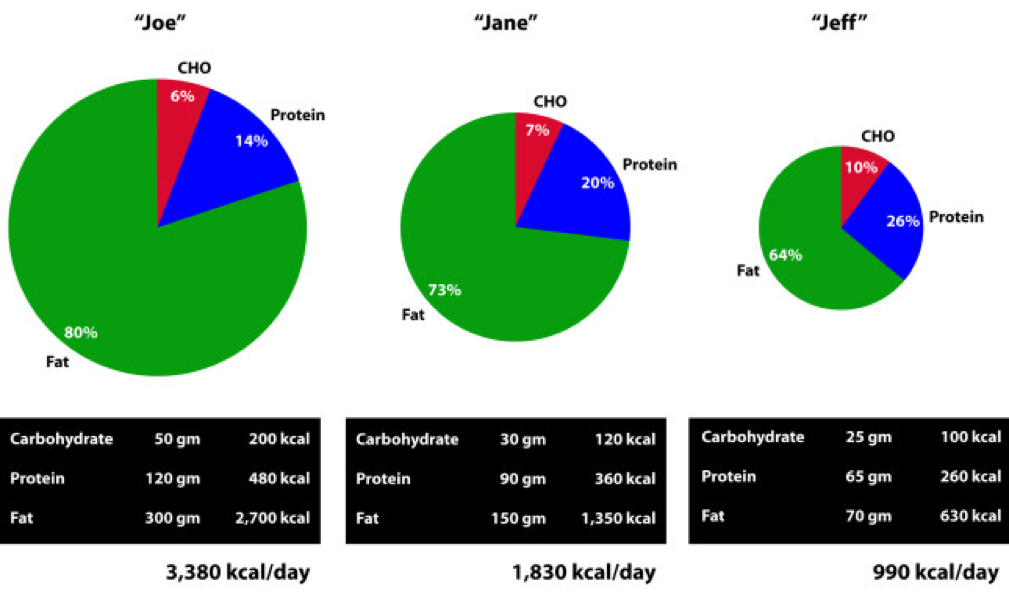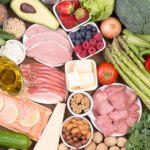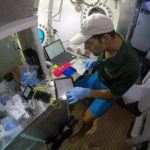For reasons I’m still struggling to understand, the idea of “nutritional ketosis” (NK, to be distinguished from starvation ketosis, SK or diabetic ketoacidosis, DKA) is often discussed and debated in much the same way as religion or politics. Perhaps this can be said of all nutrition, which is a shame. Nevertheless, in my continued defiance of such sensitive topics, I’d like to add another layer of complexity and nuance to this discussion.
The “rule of thumb” for NK is that caloric intake is determined as follows (this excludes a subset of ketogenic diets known as calorie-restricted KD which, as the name suggests, is specifically restricted in calories):
- Carbohydrate (total, not “net”): less than 50 gm/day, but ideally closer to 30 gm/day
- Protein: up to 1 to 1.5 gm/kg, but ideally below about 120 gm/day
- Fat: to satiety
Let me illustrate what this looks like for Joe (left), Jane (middle), and Jeff (right — an example of a calorie restricted KD), three hypothetical people in NK — but each with different caloric requirements.
As a general rule, as caloric requirement increases the proportion of calories derived from carbohydrate and protein decreases (and the contribution of dietary fat increases), even while absolute intake of carbohydrate and protein increases.
Anyone who has bought a blood ketone meter knows how tough it can be to get “into” ketosis by carbohydrate restriction (since everyone asks, I use the Abbott Precision Xtra meter which uses two different strips: one for glucose and one for beta-hydroxybutyrate, or BHB). Most practitioners consider the minimum threshold of NK to be a fasting serum level of BHB above 0.5 mM. I’m a bit more stringent in my practice and like to see fasting BHB levels above 1 mM. To give you a sense of one person’s numbers (mine), over a 6-month stretch in 2013, when I was in NK, my mean (i.e., arithmetic average) morning fasting level was 1.7 mM with a median value of 1.4 mM. The highest morning level during that period was 5.2 mM. (The highest morning level I have ever measured in myself is 5.7 mM.)
But, it took me a long time to get it right, especially since at the outset of my foray into NK I was consuming between 4,000 and 4,400 kcal per day. (My average daily caloric intake for weight stability was about 3,800 kcal per day, which was validated by doubly-labeled water.) I could still easily “fall out” of NK. For example, on my daughter’s 5th birthday she insisted I have some of her tikka masala (contains lots of sugar), naan bread, and mango ice cream. How could I say no to a birthday girl who insisted on going to the nicest Indian restaurant in San Diego? As to be expected, the next day my BHB was 0.2 mM, and it took me 2 days to get back above 1 mM.
Here’s a little secret I’m about to let everyone in on… I like carbohydrates. I love sushi (though I now mostly eat sashimi). I love Indian and Thai food, though I prefer to make curry myself to keep sugar out. I make (and eat) the best hummus this side of the Nile River. I’ve figured out how and when I can eat them to meet the following conditions:
- Stay in NK (except on a few occasions like my daughter’s birthday);
- Increase my anaerobic performance;
- Preserve most (but not all*) of the benefits I enjoyed when I was much more strict about my ketogenic diet.
How, you ask? By learning to calculate my glycogen deficit.
(*) For me, the leanest body composition I achieved as an adult was in strict NK with no attempts to do what I’m about to describe below. Since I’m not a model and nobody cares if my body fat is 7% or 10%, I’m happy to be a little less lean if it gives me the flexibility to increase performance and live a slightly more sane life. At least for now.
PLEASE NOTE: I have never suggested, and can’t imagine I ever will suggest, that a KD is “best” or “right” for everyone. What I describe below may seem extreme, both in the amount of work required and the actual application. I fully acknowledge that (1) this is a highly analytical approach to eating, and (2) that I’m a “freak” (my wife’s words, not mine). I certainly don’t do this often, unless a lot is on the line (e.g., a big ride), but I like having this technique in my armamentarium.
If you’ve watched my presentation from 2013 at the IHMC, then you’re familiar with RQ. Through years of metabolic testing I have a pretty good sense of my RQ at any moment in time – when I’m sleeping, when I’m sitting around (most of the time), when I’m riding my bike at 200 watts, when I’m riding my bike at 400 watts, when I’m lifting weights, etc. This allows me to calculate what proportion of my energy I derive from glycogen and what proportion I derive from fatty acid. Consider the following example:
If I ride my bike at an average of 185 watts (you’ll need a power meter to infer this) for, say, 2 hours, I know my average RQ is between 0.76 and 0.80.
The approximate formula is %CHO = 3.333*RQ – 2.333, which can easily be derived from the observation that %CHO utilized increases linearly from 0% at RQ 0.7 to 100% at RQ 1.0.
Furthermore, I know my VO2 at 185 watts is 2.9 liters per min, which means (using the Weir formula which I presented previously) my energy requirement was about 14 kcal per minute, or 1,680 kcal over 2 hours. Hence, of these 1,680 kcal needed to pedal 185 watts for 120 minutes, 336 to 554 kcal came from glycogen. In other words, I utilized between 84 and 138 gm of glycogen.
(By comparison, several years prior to being in NK, this effort in me would have taken place at a slightly higher VO2 – closer to 3.2 liters per min – and at a much higher RQ – between 0.90 and 0.95 – meaning the exact same work output would have required somewhere between 300 and 400 gm of glycogen! That’s a real state of metabolic inflexibility. Basically, I was entirely dependent on carbohydrates for energy.)
Since the first metabolic priority for ingested carbohydrate is glycogen replenishment, I can, in this setting, consume probably somewhere between 60 and 120 gm of carbohydrate following this ride and stay in ketosis. Why? Because those carbohydrates are prioritized to replenish my glycogen stores AND I am highly insulin sensitive. Note the *AND* in this last sentence. (The especially astute reader will realize some of this glycogen debt will be replenished by protein and glycerol, the latter of which is liberated by lipolysis – see post on fat flux for a primer).
Clearly I didn’t consume this amount of carbohydrate on my daughter’s birthday, so why was I out of ketosis the next day? Because my glycogen debt was not high. Of course, I knew this and didn’t really care. But, if I know my wife wants to go out for sushi one night, and I know she’s going to make me eat a California roll, I can “rig it” such that I show up to dinner with a glycogen debt appropriate enough to enjoy them without significantly interfering with my liver’s BHB production.
Extreme example
At one point, I did two tough bike rides on consecutive days. Each day we rode 110 miles under challenging conditions. Over 6,000 feet of climbing each day and very strong winds, which were either headwinds or cross-winds. On top of this, we rode pretty fast. For the purpose of illustration I recorded everything I did and ate on the second day, which I rode a bit easier than the first day.
The second ride took 6 hours and 5 minutes. My average normalized power output was 225 watts, and arithmetic average power output was 184 watts. Based on mechanical work output, this required about 5,000 kcal. Factoring in the other 18 hours of that day, my total energy expenditure was about 6,800 kcal for the day, obviously not an average day. (A detailed explanation of where the extra 1,800 kcal were expended is beyond what I want to get into now, but it’s basically the energy required to keep me alive – transport ions, contract voluntary and involuntary muscles, etc. — plus move me around, and digest food).
So what did I eat that day?
- Breakfast (pre-ride): 5 scrambled eggs, 2 sausage links, 3 pieces of bacon, coffee with cream.
- In ride nutrition (I spread this out over 6 hours): 14 oz (not a typo) of salted cashews, 2 Quest bars, 1 peach, 1 apple, 6 bottles of Biosteel High Performance Sports Drink, water. (Since I know someone will ask, I did not consume super starch this day since I was craving cashews as my carbohydrate source and was craving more sodium, given the 90+ degree temperature.)
- Late lunch/early dinner (post-ride): 2 oz ham, 3 oz pulled pork, large salad with oil and vinegar dressing, 2 slices of cheddar cheese, 6 mini hamburger patties, 2 tomatoes.
What did this amount to?
- Fat – 351 gm, or 3,160 kcal of fat
- Protein – 245 gm, or 980 kcal of protein
- Carbohydrate – 321 gm, or 1,284 kcal of carbohydrate
(I used package information and Nutritionist Pro software to calculate this.)
Hence, on this day I consumed about 5,400 kcal in total at the following ratio:
- Fat – 58%
- Protein – 18%
- Carbohydrate – 24%
By all conventional wisdom I should not have been in ketosis the next morning, right?
The following morning, my BHB level was 2.2 mM and blood glucose was 5.1 mM.
Teaching point I can’t resist: Following 2 days of significant caloric deficit, about 3,000 kcal in total, I should have in theory lost about a pound (mostly fat, possibly some muscle) which would have been noticed on a scale. Instead, I gained 8 pounds over those 2 days! Sure it was mostly water retention, both from the glycogen (small) and the fluid accumulating in the interstitial space (“thirds space” fluid losses, large) due to a systemic inflammatory response. This happens under extreme conditions of exercise. In fact, the harder I exercise, the more weight I gain, transiently. I am at my absolute lightest following 2 days of travel (i.e., rest). So before freaking out at the sight of the scale, keep in mind that most day-to-day weight movement in our bodies is indeed water movement into and out of the plasma and interstitial space, respectively.
What’s my point?
Context matters! If I ate even one-quarter of that amount of carbohydrate and two-thirds of that protein on a normal day – say, 2.5 hours of riding or 1.5 hour of riding followed by 1 hour of swimming, or a day of travel with no exercise – I would have been out of ketosis for two days or more. (Of course, my appetite on those days would not have allowed me to eat 5,400 kcal without feeling sick, but I won’t get into that until a later post.) But on this day, with these glycogen demands, I was able to maintain the perks of ketosis AND glycolysis simultaneously.
There are days, though, when I overshot my glycogen need and end up with a low BHB and high fasting glucose the following morning. Conversely, there are days I underestimate my glycogen depletion and wake up with very high BHB levels and very low glucose levels (i.e., BHB levels higher than glucose levels, when both measured in mM).
Final thoughts
I felt a bit like I was in unchartered territory because the literature on nutritional ketosis hadn’t really (to my reading) explored this level of extreme activity. In future posts, I may write about other experiences and self-experiments, including my experience with exogenous (i.e., synthetic) ketones (which I did not use on this ride, but have experimented with on other rides – no, this is not “raspberry ketones” or other such gimmicks).
2017: You can read about one of my earliest experiences with exogenous ketones in this post.
Are carbohydrates necessary to produce 225 watts or more for hours on end? Yes. But, the key is knowing how much you need and when to take them. A lower RQ at a given level of intensity means less demand on glycogen. In my experience, working with athletes and non-athletes, most tend to make two errors (for lack of a better word):
- They over-estimate their carbohydrate requirement, and/or
- They forget that no factor influences RQ – and therefore substrate requirement – more than dietary composition during lead up to event (or “life”, which is sort of the ultimate event).
Know your engine, first. Then fuel it appropriately.
Photo by CloudVisual on Unsplash







I am trying to experiment with a nutritional state of ketosis., however I eat foods high in fiber. If I am calculating carbs as carbs minus fiber, how many net carbs should I aim for in order to get in a state of NK?
I believe I am prone to insulin resistance and diabetes runs in my family. Would eating foods high on the glycemic index but that have low glycemic loads (carrots, beets, etc.) cause weight gain in someone with with an insulin resistance profile. Additionally would these foods disrupt efforts to get in a state of NK?
Im no expert but from what I read I would go strict low carb for 2-4 weeks until you’re in nutritional ketosis (blood markers 1.5-3) Then slowly add low glycemic loads and test your ketones. If you can stay in ketosis than your good if you can’t than you know you cant…that my thought anyway. Good luck!!
Hi Peter,
I started a low carb, high fat diet over a month ago and thought I did all the research I needed to before jumping in. The last two and a half weeks my ketones have been between 4.4 and 4.7 on my blood ketone monitor however I haven’t lost any weight. My blood has been stable between 60-70. I eat two large meals a day. One at 1pm and the second one at 6pm. The total calories are about 2000 per day. I enter my meals in MyFitnessPal and it seems that my fat is about 75-80% and carb 5-12% and protein 10-15%. I do drink coffee and eat dairy….should I be patient and keep going the same route or do I need to give up something ie dairy or coffee? Seems strange that my ketones are so high but not losing weight?
Thanks!
Your carb and protein shouldn’t be a percentage but a constant number. 10% of 2k is 200 and it’s too high unless you have a really high lean body mass. So for example, I try to stay 30 to 50g carb, 100g protein. If I require a high calorie intake for let’s say.. an endurance workout, the only thing that changes is the fat. Peter Attia explains this although I can’t recall the link.
I’m struggling with this one Peter……can you explain glycogen debt/deficit?
And what do you mean about the “2 errors” athletes and non-athletes make (overestimating need for carbs and nothing influences RQ more than dietary composition)?
And finally, when you say you were able to stay in ketosis after your daughter’s birthday, was it just coz your were able to shunt all that glucose into muscle cells from being much more carb tolerant/insulin sensitive after a massive workout?
Hi Peter,
great work, love your blog and take a lot of inspiration from it. Just started NK and did a VO2MAX test – inspired by your other article. I am building up for the Taupo Ironman in New Zealand 2017. I always have been a good fat burner but my VO2MAX showed extremely high fat oxidation numbers.The main credit for that goes to Dr. Phil Maffetone and his holistic training philosophy but I think NK had a big part in it too. All of your blogs about athletic performance are excellent regarding the nutritional part of it. But the way we exercise has a huge influence on carb / fat burning too and I wonder why you leave that out? What I have observed in my own training and my friends training is this: If we train above FatMax (Aerobic Threshold) and burn more carbs than fat out cravings for carbs increase. I know many very active cyclists that ride more than 10 hours per week but still have more than 20% body fat. One of the main reasons, in my opinion, is that they ride too fast. Anaerobic training and fat burning don’t match well.
Hello
I found your blog seraching the internet looking for answers…Your speech about the lady in the ER with the foot amputation hit home for me on so many levels. Both my grandfathers and my father were diabetic (type 2). I recently found out i am insulin resistant, this all makes sense to me now since i haven’t been able to loss weight in a very long time. I too am very active, working out 5 days a week and eating very healthy. Once i found out i am insluin resistant i decided to follow a very low carb diet with the guidance of an RD, but still no weight loss results, it has been six weeks.
My goal is 25% body fat, currently i am about 32%. All my blood work is good and within range except for my LDL is a little high. The blood test showed my body produces cholestrol. I check my urine ketones a few times a week for the last four weeks, they are always trace to small, never moderate. I have scaled down my workouts, per my doctors orders, thinking my body is over stressed. My gut is telling me the insulin is preventing me to loose the extra fat, Can you give me a advice? Help…Thank You!!!!!!!!
I am not sure you will see this comment, as it comes so late after the original post but I HAVE TO ASK—–can you please share your hummus recipe?? 🙂
Peter:
I am a relative newbie biker, but in trying to parse all the moving parts, given that following an exercise induced glycemic debt, it seems that you now have the choice of administering carbohydrate to replenish your depleted muscle glycogen without compromising your ketotic state, or NOT replenishing your muscle glycogen by administering carbohydrate, or perhaps only partially replenishing.
The reason I raise the question of reasonableness of choice is that I note that part of the price for “carbo-loading” is that with the full load of glycogen replenishment you also get an 8 pound obligatory water load to go with it. In the old (high carbohydrate diet) days of simplistic refuelling theory my choice would have been obvious — muscles can only function on glycogen, so it must be replenished. Now, with my more nuanced understanding of the flexibility of fuels for a ketotic athlete, I wonder if your choice might be affected by the nature of your ride tomorrow. If it was to be a largely flat course, then go for the CHO loading. But if a lot of climbing was involved, would it be reasonable to consider NOT CHO-replenishing, given that weight is a huge performance penalty in climbing?
Certainly, from the running perspective weight is a penalty even on flat stretches, so I am grappling with this equation. (Life was so much easier when there was only one principle — “Carbo Loading Is a Good Thing”).
Oh, supplementary questions: Regarding the Abbot Glucose and Ketone meter, somewhere buried in the myriad answers you let drop that you buy the blood strips “cheaply, in Canada”, and keep on the lookout for bargains. Leaving aside the observation that something marketed in the US may be found cheaper in Canada is an anomaly, where do you get yours? Are we limited to using Abbot brand, or are all the advertised strips chemically equivalent? Do you have any current feedback on the reliability and usefulness of the exhaled breath acetone analysers?
OK: Here’s a data point from my own N of 1. I just did my first 10 k race of the year, a course that I’ve regularly done early in the season in 44 minutes plus or minus. Last year I did it in 43:40, a best in 6 years despite creeping age lol. However, I am actually trying to optimise for an Ironman in August. So I have been more or less high fat low carb for a year, and I suspect I have been on the cusp of ketosis or actually in ketosis intermittently for a year while training fasting in the morning for 2 hours before bacon and eggs and sardines breakfast. But since finding this blog and clarifying on the science this past week, I have been more precise, and I estimate I have been below 30g CHO daily. Now I’m only 51kg, so maybe that’s not low enough for my per kg calculation, but I don’t know. A knowledgeable endurance competitor and coach suggested I carb up “slightly” because the 10k race is a somewhat higher intensity effort than the 3 to 6 to 12 hour races I am primarily aiming my diet for. However, I feared that whatever carb overload I prepped myself with would cause a glucose spike as it drove glucose into muscle and liver, and through the insulin response turn off my ability to oxidise fat, leaving me with the worst of both worlds — not enough glycogen for a full out effort, and without any back-up ability to metabolise fat. So I declined, and did not carbo load at all, keeping to my same old low carb diet till the night before, and not eating a breakfast before the race,
This morning’s race started ordinarily enough, but by 3k I noticed my k times were slipping and by 5k there was definitely a time deficit relative to what my training normally would have predicted. By 7, 8 and 9k I was slowing down despite considerable puzzlement and trying to force the pace. My eventual time of 47:20 was despite optimum effort, and usual attempted sprint at end, and complete exhaustion at the finish line.
So, what went wrong?
Possibly my last 2 weeks of strict CHO restriction to 30g was the first time that I was consistently in ketosis, and I was not yet fully keto-adapted?
Or would even full keto-adaptation only allow for a maximum rate of fat oxidisation that delivered less power than the full power I was used to producing in a 10 k running race (on my prior high CHO diet)?
If the latter situation is true, is there a way to CHO load without prior maximal exertion and glycemic debt, which might not be prudent the day before a 10 k race, and still not shut off the capacity to oxidise fat (i.e. ideally provide for maximal glycogen burning and simultaneous muscle fat burning at high rates).
There may be other possibilities for the mismatch in expectation and performance, but I can’t think of any other. I followed my usual training protocol, with typical speedwork and appropriate tapering of volume. My legs are pretty sore as would be expected after a maximal effort.
It’s a pity I didn’t verify that I actually was hitting ketosis, but I wasn’t getting hungry when meals were due, and subjectively I was feeling ok, despite intensive exercise during morning fasting, so my educated guess is that I was in ketosis.
I have just borrowed a ketone/glucose meter tonight and will start checking tomorrow. Very Interesting.
After 2 and a half days of frequent checking blood glucose and ketones, as I suspected, I was continually in the lowish (compared to “normal”) glucose range, 4.4 to 5.4 mM (multiply by 18 to get mg/100ml) and BHoB 0.4-0.9 mM with spikes to 1.3 after exercise. Whether that has been in place for a year or only been going on for 2 weeks is another matter.
Tracking glucose and BHB fairly closely this past 10 days, apart from the expected ketosis results sometimes, I have noticed some anomalies that I can’t explain. I initially thought there might have been instrument artefacts, but the same pattern has happened on several occasions. Essentially the anomaly is sort of high in the evening, low in the morning, then rises during exercise. (On other occasions, glucose drops as expected with exercise and BHB rises).
Last night at 11 I registered a rather high glucose for me 6.1mM about 5 hours after I ate about 130g of pork, say 25g protein and a small slice of chicken pie, say 15g CHO in the crust. I had only coffee with cream 2 bacon 2 eggs and a can of sardines that morning, no CHO. I’m about 51kg body mass.
This morning at 8:20 my fasting glucose was 4.6. I didn’t eat and ran 16.3k, doing the last 2k in a sprint, taking 90 minutes. Immediately after this my glucose was 6.1, despite exercise and no intake. BHB remained low at 0.3 as expected with this high glucose level.
The only explanation that I can think of is that my CHO intake may have drifted slightly above my arbitrary 15-25g limit between 2 and 3 days ago (I’m experimenting leading up to a Half Marathon). But subsequent morning fasting glucose levels were suitably low again.
Perhaps a “suitably low” glucose level in the morning may be the result of a glucose spike during the night with an insulin surge?
But it is hard to see why I would have had much of a glucose spike last night, unless I am grossly underestimating the CHO in a small wedge of pie-crust.
And after an initial reading of 4.6 this morning, where did the glucose come from to give a reading of 6.1 after exercise? Liver Gluconeogenesis? Maybe the glucose level dropped so low during exercise (I wasn’t feeling particularly great, but I didn’t notice any shakiness) that there was an epinephrine surge? And if this was the mechanism, wouldn’t some fat mobilisation have occurred? Or does BHB take several hours to show this? (I have had my BHB rise within 1.5 hours of exercise on other occasions). Teasing out this CHO/exercise, glucose and ketone dance is indeed a puzzle.
Don’t want to drag this out unnecessarily, but surprises continue. Immediately after this morning’s post-run Glu=6.1, BHB=0.3 I ate a modest meal with about 8gCHO. 8 hours later, with no further food intatke, Glu=3.8 and BHB=2.6. If there is a pattern here it may be that BHB takes several hours to rise. Maybe acetoacetate was high or rising initially, but BHB at that time had yet to rise (from acetoacetate transformation). But that still doesn’t explain the glucose rising during the (fasting) exertion of the run.
Such a fascinating topic! Thank you for sharing this info.
I am currently 36 weeks pregnant and have been testing positive for ketones in my morning urine for the last few weeks. I do not have Gestational Diabetes. I have tested my blood glucose consistently over the past few weeks and, if anything, tend to have lower glucose levels (although I am not technically hypoglycemic). There is so much information on the web about how dangerous ketones are during pregnancy, but much of this connects ketones to GD. After reading your blog, I am inclined to say I am experiencing nutritional ketosis and not diabetic ketosis.
What I find puzzling about my ketone situation is that my weight gain and diet have been great. I have gained about 40 lbs in my 36 weeks, so why would my body be so quick to enter ketosis? I eat a solid snack before bed, but will test positive for ketones a mere 6 hours later… How can weight gain and ketosis co-exist? Obviously some of this weight gain is baby, placenta, fluid, etc, but certainly some of it is fat.
I feel very healthy and have tons of energy, so I am not particularly concerned about the ketones. I am just curious about what is happening in my body.
Your thoughts would be much appreciated!
I’m not an expert, but have heard from others more knowledgeable than me that babies are in ketosis in the womb. So the ketones in your urine could be from the baby since you are peeing for two 😉
I’m a type 1 diabetic and find when I exercise my glucose levels rise 2 hours after exercising and morning glucose levels are high about 170. Do you have any explanation for this and how to avoid the high glucose levels? Thank you!
Stumbled across this article by chance. Well written, and does seem to confirm what I’ve been seeing with my own workouts. I’ve tried CKD and SKD before, and after a week or so I’d just end up obliterated, so I’ve been trying TKD. People were recommending to consume between 20 and 50 carbs total pre and post workout, and I’ve been noticing that even when I’m around 50, I’m ending up in a keto state less than an hour or two post-workout, and my energy was still low. I then upped it to 100, and I’m still back in ketosis quickly. Guess I’m just gonna keep experimenting with increasing it (to the point where the calorie total doesn’t damage my other macros), and this is only with an hour and a half of weightlifting and 30 minutes of HIIT.
One thing I’m quite curious about is how much genetics affects the sensitivity to carbs and maintaining a keto state. I know some people can’t even exceed 20 on workout days, and it seems that’s just nowhere near enough for me.
Thanks again for the article!
What are your opinions on the Cyclical Ketogenic Diet? Adapting to keto than lets say for one day every 7-10 days loading moderatly (not binging) on glucose generating carbs, so no sugars, no fruit, just bread, rice, yams?
Dear Peter.
Great articles! Yours were the only I found that dived into the chemistry of it all. Congrats!
Well. My question is really simple, but none has answered it yet.
If I am supplying lots of fats to stay in ketosis, why would the body burn my own fat? Why would I loose weight if I can eat fat in an unlimited manner.
Thank you.
Not clear it will in the case of “lots.” See the post on fat flux.
Dear Peter,
Loved your article and how you go about all this! One question: What are the time scales of “glycogen deficit/debt?” Meaning how soon is the deficit made up by the body through gluconeogenesis and lipolysis if I don’t consume carbs within that period. Practically, it amounts to: Since I love carbs and am brand new to experimenting with ketosis (because of metabolic-syndrome like presentation: lean but high triglycerides, low HDL), if I accumulate a (an even small) glycogen deficit or debt, how long do I have to indulge in my favorite carbs? Common-sensically, I’d think an hour or two, but I’m sure you have a biochemistry and evidence-based answer. I realize this could get complicated, e.g., from its dependence on the magnitude of the deficit or debt etc…, but I’m sure your answer will be insightful. (if necessary you could assume the deficit as arising from a 1000 kcal effort starting with no deficit while in NK.) This would be very helpful in hacking NK to satisfy my own carb-cravings and, like you, give my wife a break from the NK-nonsense
Thanks
Just a general comment here because my diet is little like your experiments with yourself. I work hard to hit my protein intake as my single biggest dietary goal (1.00gm / kg bodyweight = 53gm / day) with nuts, legumes, green leafy veg, salad, eggs etc, before adding in fruit and yoghurt, occasionally cheese. The only fat I take in is in what’s contained in those ingredients. I don’t do alcohol and coffee.
I’m in a keto state generally (based on RER measurements – .64) and even at a V02 max (peak) don’t hit 1.00 (only .94). I train long distance running. I don’t use ketone measurements because I don’t vary my diet (even for my daughter’s birthday).
Perhaps my consumption of legumes etc prevents a keto state and I just happen to be in it when I do V02 max tests (or RQ, RER is a poor measure). But being able to run several hours and not eat, or feel hunger, would also tend to suggest that I’m fat-adapted.
It’s not only a high fat diet that will attain this state.
Dr Attia – I’ve encountered your blog here only tonight – you are a sheer pleasure to read. Love your geeky mix of discursive observation with apropos, deep insightfulness. Please carry on!